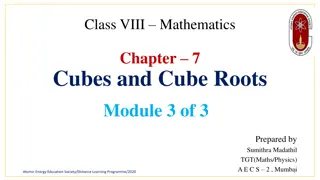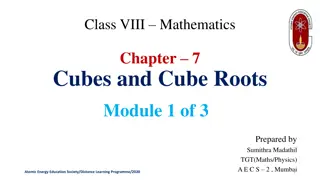Innovative Redesigns of the Rubik's Cube for Inclusivity
Explore redesigned Rubik's Cubes to overcome barriers like accessibility for visually impaired individuals and color blindness. Solutions include Braille versions, raised shapes for color-blind users, and universal design with easy colors. Virtual cubes and classroom activities are also highlighted, promoting engagement and learning in diverse settings.
Download Presentation

Please find below an Image/Link to download the presentation.
The content on the website is provided AS IS for your information and personal use only. It may not be sold, licensed, or shared on other websites without obtaining consent from the author.If you encounter any issues during the download, it is possible that the publisher has removed the file from their server.
You are allowed to download the files provided on this website for personal or commercial use, subject to the condition that they are used lawfully. All files are the property of their respective owners.
The content on the website is provided AS IS for your information and personal use only. It may not be sold, licensed, or shared on other websites without obtaining consent from the author.
E N D
Presentation Transcript
REDESIGN THE RUBIK S CUBE Based on your learning so far, discuss what barriers a traditional Rubik's cube might have. Then consider possible solutions we could include in the design to provide access for those barriers
BRAILLE RUBIK'S CUBE Braille version of Rubik s cube
COLOR BLIND RUBIK'S CUBE Color blind version of Rubik s cube using raised shapes on squares.
UNIVERSAL DESIGN RUBIK S CUBE Universal design of Rubik s cube. Uses raised shapes and easy colors.
VIRTUAL CUBES Virtual Cube examples 2x2 Pocket Cube 3x3 Rubik s cube 4x4 Revenge cube 5x5 Professor cube 6x6 V-Cube 6 7x7 V-Cube 7 virtual cubes Virtual Cubes Instructions Color variations Dual-colored Faces Four-colored Faces Eight-colored Faces Tartan Cubes Super Cubes Sudoku Cubes Picture Cubes Globes
GO MATH SAMPLE LESSON 2ND GRADE Roles: Group 1: Students in the classroom participating in the lesson Group 2: Observers writing down what was seen in the lesson
CLASSROOM EXPECTATIONS 1. Students will be respectful to all members of the learning community 2. Students will explain their thinking and the thinking of others 3. Students will ask questions when they do not understand 4. We will all work together as equal members of the learning community Routines: CHAMPS expectations are put in place for activities Teacher/Student Game to reinforce CHAMPS Playing Cards
WELCOME BACK FROM RECESS TODAY S ACTIVITIES Group/Partner Talk C- Voice Level 1 H Ask your partners Raise your Hand A- Solving Math Problems Together M- Getting supplies P Speaking and listening Mathematicians Class Discussion C- Voice Level 0 listening Voice Level 2 Speaking H Raise your Hand Silent Signals A- Learning about Math M- None P Speaking and listening Mathematicians Independent Work C- Voice Level 0 H Raise your Hand A- Solving Math Problems M- Teacher Permission P Completing math work S- Mathematicians are learning and growing together
WARM UP 1: How many ways can you make the number? 25
WARM UP 2: How many ways can you make the number? 36
HOW CAN WE USE THE SAME STRATEGY TO DESCRIBE EACH OF THE NUMBERS 25 36 42 27 Your own number 48
OUR QUESTION OF THE DAY: HOW CAN I BREAK APART ADDENDS TO ADD NUMBERS?
TRY THIS PROBLEM Jennifer has 27 Pok mon cards on her desk and Belinda has 48 Pok mon cards. If you put all of the cards into a pile, how many cards would you have altogether?
WORK WITH A PARTNER TO SOLVE THE PROBLEMS Break apart the addends to find the sum of 35 + 54. I. 35 _____ + _____ II. 54 _____ + _____ Break apart the addends to find the sum of 43 + 29. I. 43 _____ + _____ II. 29 _____ + _____
PRACTICE TIME: PRACTICE YOUR WORK (15 MINUTES) Appetizer (Everyone Must Do): Math Workbook 4, 5, 6, 7 Entr e (Choose 1 to Complete): Work with a Partner: Math Workbook 8, 9, 10 Computer Time: Personal Math Trainer Group Work: Work on Math with Mrs. Dozier Dessert (Complete if you have time): Poster: Create a word problem poster using 2 digit addition, make an answer key on the back Enrich Worksheet Game with a Partner: 2 Digit Shuffle
EXIT TICKET Julie read 19 pages in her chapter book on Monday. She read 12 pages on Tuesday. How many pages did Julie read this week? Show your work.























